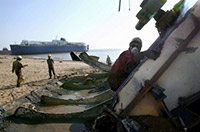Shipbreaking linked to asbestos illness in Indian report
by Tripti Lahiri, Yahoo News
 |
 |
 |
 |
| |
 |
|
| |
Photo taken January 2006 shows Indian workers dismantling decomissioned ships at a shipbreaking yard in Alang. A Supreme Court committee has said that one in six workers at the world's biggest shipbreaking yard in western India shows symptoms of the fatal illness asbestosis. ©AFP/File/Emmanuel Dunand |
|
 |
 |
 |
|
| |
6 September 2006 (New Delhi) –
One in six workers at the world's biggest shipbreaking yard in western India shows symptoms of the fatal illness asbestosis, a Supreme Court committee has said.
Of 94 workers exposed to asbestos while working at Alang shipyard in Gujarat state, 15 showed abnormalities "consistent with asbestosis" in X-rays, according to the report, part of which was made available to AFP by an environmental activist on Tuesday.
Asbestosis is an incurable disease caused by exposure to asbestos that destroys the lungs and eventually kills its victims.
The Supreme Court has been waiting for the report to help decide the fate of a cruise ship sold by its French owners in 1979 and now named the Blue Lady, which is docked at Alang and owned by Indian shipbreakers.
The committee set up by the Supreme Court reported its findings on August 31 but they have not yet been made public.
Environmental groups say the vessel contains 1,200 tonnes of harmful polychlorinated biphenyls as well as carcinogenic asbestos and should not be broken up at the shipyard.
The workers examined in the study had been engaged in removing asbestos from ship insulation linings.
In addition, the report said the annual fatal accident rate at the shipyard was two per 1,000 workers, six times that of the mining industry, which is considered the most "accident-prone" in India, according to environmental activist Gopal Krishna, who had seen the full report.
The committee based its findings on a survey of Alang workers conducted by the National Institute of Occupational Health.
"Here is an admission from the government side which vindicates our point," said Krishna, local coordinator of the Global Platform on Shipbreaking, which has been calling for more stringent standards at Indian shipbreaking yards.
Most seagoing ships end their lives at shipyards in India, Bangladesh, China and Pakistan, where activists say they are broken up by unprotected workers.
"We've been saying for a long time that once workers get exposed to asbestos they are bound to suffer from these diseases," Krishna told AFP.
For major industrialised nations, safety and environmental laws make shipbreaking work hugely costly.
But in the developing world, lax enforcement of safety and environmental rules and a vast supply of cheap labour can make shipbreaking a profitable proposition.
Last year, France recalled the decommissioned warship Clemenceau after a battle by environmentalists who said it contained between 500 to 1,000 tonnes of asbestos. France said the ship only contained 45 tonnes of the material.
Environmental groups have said the court should refuse to allow the ship to be broken up at the shipyard Alang, located on a remote stretch of coast nearly 200 kilometers (160 miles) northwest of India's financial centre Mumbai.
But one shipbreaker praised the new report and said it would help workers, blaming a small number among about 150 companies operating at Alang for putting their health at risk.
"It's only about four or five. Ships... cannot be broken by an irresponsible ship yard," said Girish Luthra, chairman of Gujarat Enviro Protection and Infrastructure, which was due to clean up the Clemenceau.
"The report is going to do the job. Ultimately it will be to the favour of the industry."
FAIR USE NOTICE. This document contains copyrighted material whose use has not been specifically authorized by the copyright owner. The Basel Action Network is making this article available in our efforts to advance understanding of ecological sustainability and environmental justice issues. We believe that this constitutes a 'fair use' of the copyrighted material as provided for in section 107 of the US Copyright Law. If you wish to use this copyrighted material for purposes of your own that go beyond 'fair use', you must obtain permission from the copyright owner.
More News
|